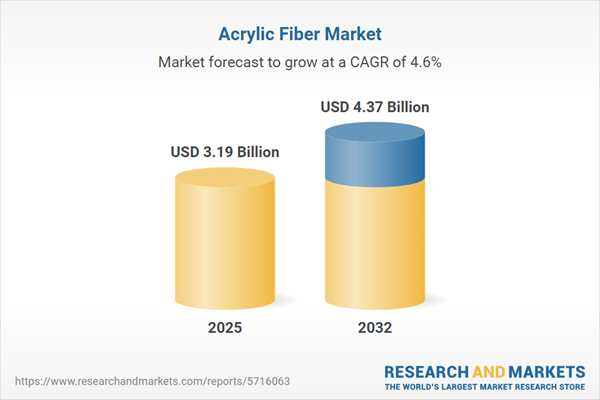Speak directly to the analyst to clarify any post sales queries you may have.
The acrylic fiber market is entering a period of accelerated transformation, with regulatory changes, technological advances, and diversifying end-use requirements prompting manufacturers and supply chain leaders to rethink their competitive strategies and operational models.
Market Snapshot: Acrylic Fiber Market Overview
The global acrylic fiber market reached USD 3.05 billion in 2024, with projections indicating an increase to USD 3.19 billion in 2025 and momentum aiming toward USD 4.37 billion by 2032, reflecting a compound annual growth rate of 4.57%.
Strong demand sustains traditional sectors like clothing and home furnishings, while technical and industrial use cases are becoming more prominent. Advances in polymer chemistry enhance the adaptability of acrylic fibers, broadening their functionality across both mature and emerging applications. Digital supply chain solutions are improving industry response times and enabling better product differentiation in global textile markets.Acrylic Fiber Market Scope & Segmentation
- Type: High Wet Modulus Acrylic fibers are chosen for robust strength and prolonged durability in demanding textile environments. Modacrylic fibers offer flame resistance to meet strict fire safety criteria, while Standard Acrylic remains a versatile selection for a spectrum of consumer and industrial products.
- Form: Staple fibers dominate in apparel and home goods due to their tactile comfort and flexibility. Tow fibers are key for industrial-scale processes that require consistent outcomes and efficient throughput.
- Application: Uses include outerwear, hosiery, knitwear, bedding, carpets, industrial filtration, ropes, twines, and curtains. This highlights acrylic fiber’s ability to satisfy both broad market needs and specialized technical requirements.
- Production Process: Dry Spinning delivers quick turnaround for adaptable supply, while Wet Spinning is used when precise control of fiber characteristics and adherence to higher standards are necessary.
- Distribution Channel: Direct B2B channels create resilient supplier connections and streamline procurement cycles. Online platforms expand access for buyers, and retail outlets continue to serve business and individual end users.
- Geographies Covered: The acrylic fiber market covers the Americas, Europe, Middle East & Africa, and Asia-Pacific, with major production centers in China, India, Japan, and Southeast Asia, where companies balance diverse regulatory and supply chain demands.
- Major Companies Profiled: Grasim Industries Limited, Aksa Akrilik Kimya Sanayii A.Ş., Sateri Holding Limited, Jilin Chemical Fiber Group Co., Ltd., Mitsubishi Chemical Corporation, Sinopec Shanghai Petrochemical Company Limited, Toray Industries, Inc., Formosa Plastics Corporation, Nilit Ltd., and Kaneka Corporation play central roles in shaping product innovation and sector capabilities.
Acrylic Fiber Market: Key Takeaways for Senior Decision-Makers
- Upgraded spinning techniques and fiber modifications accelerate product adaptation, helping organizations align with changing consumer and industrial expectations.
- Specialty fiber developments offer expanded procurement options, supporting technical challenges like fire safety and next-generation moisture management.
- Collaborative partnerships with upstream suppliers help embed recyclability and improved environmental performance throughout the value chain, reinforcing compliance and sustainable practices.
- Wider use of digital supply chain and analytics technology improves distribution transparency, assisting leaders in reducing operational waste and elevating logistics performance.
- Regional strategies are adapting: supply chain resilience and nearshoring are key in the Americas, Europe advances circular economy initiatives, while Asia-Pacific leverages bespoke manufacturing to address diverse customer needs.
Tariff Impact: U.S. Trade Policy and Supply Chain Recalibration
Recent adjustments in U.S. tariff policy have prompted producers, notably in Asia-Pacific and Europe, to review and recalibrate sourcing and contractual approaches. Many organizations are prioritizing enhanced logistics oversight and more detailed regulatory monitoring to safeguard their market position and agility under shifting global trade conditions.
Research Methodology & Data Sources
This report utilizes data drawn from top trade associations, industry research publications, and up-to-date regulatory materials. Expert perspectives are gathered through executive interviews, targeted surveys, and consultations with technical specialists, providing insights that address concrete operational challenges in real time.
Why This Acrylic Fiber Market Report Matters
- Enables senior executives to benchmark their strategic direction, enhance regulatory foresight, and identify relevant technology adoption opportunities.
- Presents a comprehensive review of market segmentation and regional trends, informing smart decision-making in procurement, investment, and operational optimization.
- Delivers focused guidance for procurement and operations leaders working toward continuous process improvement as conditions and compliance requirements evolve.
Conclusion
Integrating regulatory knowledge, material advancements, and digital supply chain strategies is vital for competitiveness in the acrylic fiber market. Organizations that strengthen these capabilities will be positioned to adapt to future changes and secure lasting growth.
Additional Product Information:
- Purchase of this report includes 1 year online access with quarterly updates.
- This report can be updated on request. Please contact our Customer Experience team using the Ask a Question widget on our website.
Table of Contents
3. Executive Summary
4. Market Overview
7. Cumulative Impact of Artificial Intelligence 2025
Companies Mentioned
The companies profiled in this Acrylic Fiber market report include:- Grasim Industries Limited
- Aksa Akrilik Kimya Sanayii A.Ş.
- Sateri Holding Limited
- Jilin Chemical Fiber Group Co., Ltd.
- Mitsubishi Chemical Corporation
- Sinopec Shanghai Petrochemical Company Limited
- Toray Industries, Inc.
- Formosa Plastics Corporation
- Nilit Ltd.
- Kaneka Corporation
Table Information
| Report Attribute | Details |
|---|---|
| No. of Pages | 198 |
| Published | October 2025 |
| Forecast Period | 2025 - 2032 |
| Estimated Market Value ( USD | $ 3.19 Billion |
| Forecasted Market Value ( USD | $ 4.37 Billion |
| Compound Annual Growth Rate | 4.5% |
| Regions Covered | Global |
| No. of Companies Mentioned | 11 |









